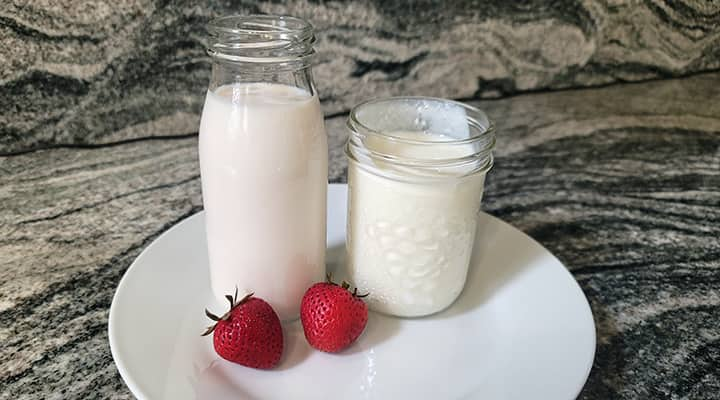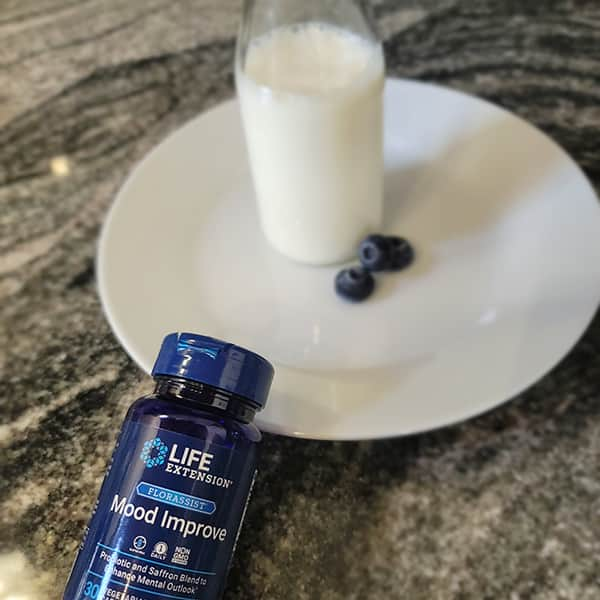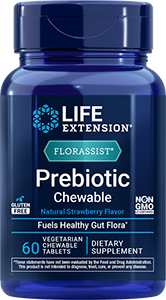
Is Kefir Lactose Free? Uses, Benefits & How to Make It
Published: September 2022
Have you ever wished those cute little drinkable yogurts made for kids were offered in adult sizes and flavors? Fortunately for you, there is something better. With very little lactose, and loads of beneficial bacteria to nourish a healthy gut microbiome (aka probiotics), milk kefir takes drinkable yogurt to the next level.
Let's dive into the benefits and nutritional profile of this tasty, gut-nurturing drink, explain whether it's a good choice for people who need to avoid dietary lactose and what makes it different from other good-for-your-gut foods you may have heard of, like kombucha and yogurt.
And if you're ready to take the plunge and give kefir a try, check out our tips to make your own delicious beverage—customized to your preference for creaminess and fizziness.
What is kefir?
This fermented milk drink is yogurt-like in taste but it is more liquid-like in consistency and it has a fermentation process all its own. Kefir originated in the Caucasus Mountains region of Eastern Europe (some say milk kefir grains were a gift from the gods), and it has spread worldwide. It is made using kefir grains, which are not actually grains like rice or wheat but globules of good bacteria and yeast. These kefir grains are unique. Other fermented dairy products, such as yogurt, do not form grains during fermentation—only kefir does.
Kefir grains can also be used to make water kefir, which is more fizzy. The water kefir grains are different, feeding not on lactose during fermentation but on the sugar in the sweetened water, juice or coconut water that surrounds them. Both water and milk kefir grains are cauliflower-like and have a slightly rubbery, gelatinous texture. But water kefir grains are clear, while milk kefir grains are white, appearing similar to cottage cheese.
Health benefits of kefir
Thanks to its fermentation, milk kefir contains good bacteria and has the most naturally occurring probiotics among fermented dairy products. The Lactobacillus in kefir produces a compound called kefiran that can help support the growth of good bacteria in your gut microbiome. Among other health benefits, it helps to fight oxidation and provides support for immune system health, already-healthy blood pressure and a healthy inflammatory response.
Studies have shown drinking kefir supports digestive comfort and gut health, promotes already-healthy cholesterol levels and supports a healthy immune system response, thanks to the probiotics naturally present in fermented kefir.
Probiotics have risen to the top of the wellness field because of their health benefits throughout the body. They not only support immune system and digestive health, but also benefit heart health, oral health, mental health and longevity. And kefir is full of them.
Pro tip: Although kefir is fermented milk, the lactic acid and bacteria change the milk, which changes its nutritional profile. Kefir has less fat and fewer calories than milk, but more protein and more carbs (so it isn't suitable for keto diets). Kefir also has more calcium and magnesium, making it good for bone health.
Is kefir lactose free?
Milk kefir is not lactose-free. The fermentation process of milk kefir grains reduces the lactose greatly, but it still contains trace amounts. If you avoid eating animal products or cannot tolerate lactose, some store-bought brands offer non-dairy and lactose-free kefir. You could also try the non-dairy route at home, making a batch or two of coconut milk kefir using milk kefir grains. But you would have to switch back to dairy-rich milk for the next batch to keep the kefir grains thriving.
What does milk kefir taste like?
Plain kefir is similar in taste to plain yogurt, with a slightly tangy taste and creamy texture. Many store-bought brands add fruit flavors, such as vanilla, strawberry, blueberry and mango. When making your own, the fermentation adds a bit of effervescence to your drink. You can encourage this effect by adding fruit to your kefir in a second ferment, which is a good way to introduce more bubbles, sweetness and flavor to your drink.
Kefir vs. yogurt vs. kombucha
Although it also packs a probiotic punch, kombucha is very different from both yogurt and kefir because it is a fermented black or green tea beverage. Yogurt and kefir are dairy-rich, fermented milk products. Yogurt is thicker than both kefir and kombucha, and it doesn't contain the yeast that makes kefir and kombucha fizzy. Of the three, kefir generally has the most probiotics thanks to the kefir grains, but both yogurt and kefir have the fat and sugar content of dairy. Kombucha is fat-free but contains caffeine and can have a lot of added sugar.
How to choose the best kefir milk?
Store-bought kefirs are produced in a variety of flavors, with dairy-free and lactose-free options. When choosing the best kefir for you, keep an eye on the ingredients label. Most commercial kefirs add sugar and thickeners, and they start with a powdered culture for a more consistent product instead of using grains to ferment the milk. Making kefir at home is a good option to lower costs, and it gives you more control over added sugars and kefir thickness and taste. Plus, you get the health benefits of kefir grains and active fermentation.
When should I drink kefir, at night or in the morning?
One of the most important things about any aspect of wellness is consistency, whether we are talking about taking a supplement, exercising or drinking kefir. There isn't really scientific evidence as to when is better for drinking milk kefir or for taking probiotics. It mainly comes down to when is best for you.
Some prefer to drink kefir in the morning or as an afternoon snack. Others find it calming to drink at night, similar to having a glass of warm milk before bed. Because there isn't one best time to take probiotics, your digestive comfort and routine should dictate when you drink kefir. In general, though, bacteria like those in probiotics are sensitive to heat, so allow 30 minutes before or after a hot cup of coffee or tea.
Who shouldn't drink kefir?
People who avoid dairy and milk or who may have difficulty digesting lactose should avoid dairy-based kefir. The fermented milk has most of its lactose converted to lactic acid during fermentation, but lactose is present. Non-dairy kefir is a good option, or you could try making an oat milk at home instead.
Some studies support consuming milk kefir to support lactose digestion and tolerance. For optimal digestive comfort, stick to plain flavors, which tend to be tolerated best.
Explore Our Best Digestive Health Supplements
How To Make Milk Kefir at Home: 3 Ways
Ready to try your hand in the kitchen? Kefir is a healthy, delicious way to get the benefits of probiotics into your daily diet, and making it is easy!
There are three ways to ferment your own milk kefir:
Simplest option: Start with a store-bought kefir
. This is the easiest way to make kefir without grains. You need only a gallon of milk (1%, 2% or whole) and store-bought milk kefir (plain or flavored). First, pour out a glass of milk. Then shake your kefir and pour it into the milk gallon to refill it to the top. Put the lid on tightly, shake the gallon and set it on your counter for 24-72 hours. Shake it every 12 hours. You will begin to see kefir fermenting and culturing on the bottom. Start pouring off a little to taste it at 24 hours, and every 12 hours after that, to get the taste and consistency you desire. Kefir will ferment faster at higher temps, but any temperature between 68 and 82 degrees should be fine. Put it in the refrigerator to stop the fermentation.Medium-difficulty option: Start with a powdered kefir starter
. You can purchase this starter culture in a health food store, specialty grocery store, or online. A starter is made up of active bacterial cultures, lactic yeasts and skim milk powder. With this method, follow the manufacturer's instructions. But in general, you first boil your milk and then cool it before adding the starter. Once the starter culture is mixed in, transfer the milk to a clean container and sit out on your counter to ferment until a curd begins to form (about 24 hours). Refrigerate and enjoy.Most complicated option: Start with kefir grains
. Although this method might seem intimidating, it is the best way to enjoy long-term kefir making because the kefir grains will continue making kefir as long as you add milk. This method also allows you to experiment to find the consistency and flavors you enjoy most, and it doesn't require boiling milk (although some prefer to do this).
Ingredients
Kefir grains
Fresh milk (1%, 2% or whole)
Preparation
- If you order fresh kefir grains online or get them from a friend, activating them is as simple as putting your kefir grains in a clean glass jar and covering them with 1-2 cups of fresh milk.
- Cover the jar lightly (do not seal) and set it on the counter to ferment for 24-36 hours. Do not disturb the jar during fermentation.
- Once the curds begin to separate from the whey, shake or stir well, then drain the kefir through a plastic (not metal) strainer.
- Collect the kefir grains, stirring to separate them from the curds. Then add them to a clean glass jar, cover with 1-2 cups of fresh milk and start the fermentation process again with a new batch.
- If you ordered your grains online, you will discard this first batch of kefir milk. If the grains are already fully activated, strain your kefir again to homogenize it and transfer it to a clean container.
- Enjoy right away, chill in the refrigerator, or go for a second fermentation. Just add a little fruit to the milk kefir and allow it to sit in a cool place (or the fridge) for a few more hours to add flavor and effervescence.
- Fermented kefir should be stored in the refrigerator. It may continue to separate lightly, so always give it a good shake before you drink it.
Nutritional Values
The nutritional value of milk kefir varies depending on the milk you start with.
Lifeway® Kefir, plain 1%, 1 cup
Calories 110
Total Fat 2 g
Sat Fat 1.5 g
Cholesterol 10 mg
Sodium 125 mg
Total Carb 9 g
Fiber 0 g
Sugars 9 g
Protein 10 g
Vitamin D 3.8 mcg
Calcium 390 mg
Kefir preparation tips
While creating a tasty, nutritious kefir isn't rocket science, it's also not as easy as popping open a store-bought bottle. Follow these simple tips to craft kefir fit for a king (or queen)!
DO keep a close eye on your kefir
. Once the milk is fully fermented, the process doesn't just stop. The biological activities will continue. So, it is important to remove the kefir grains and chill your kefir as soon as it reaches the state you prefer. Once the curds and whey separate, the kefir turns soupy instead of creamy. Also, the tangy taste increases with fermentation. So if you prefer a lighter, creamier drink, remove the grains and chill it as soon as the milk shows signs of being processed all the way through. Try not to over-ferment it.DON'T let over-fermentation stop you
. No reason to toss aside all of that hard work if you didn't watch the kefir as closely as you should! You can still drink over-fermented kefir. Let taste be your guide on whether you use it or toss it. Some people prefer to drain the whey, but the whey has health benefits, too, even if it is tangy. You can also use over-fermented kefir in smoothies, baking, etc.DO care for your grains
. Leaving grains in the same milk for more than 48 hours can damage them because it starves the grains. So, make sure they are getting plenty of fresh milk. Do not use metal spoons or containers, as this can also hurt the grains, and don't wash them with chlorinated water. If you do rinse them, use spring water. That being said, they don't need to be rinsed between batches. Just make sure you separate the curds, which should not go with the grains into a new batch of milk.DO try different types of milk to figure out what you like best
. Whole milk makes a creamier kefir, and it is loaded with nutrients for both you and your grains. Milk kefir grains should be used with dairy milks, but they can be used to make a batch or two of coconut milk kefir every once in a while. Just be sure to feed them well with fresh milk afterward to keep them thriving. Stay away from ultra-pasteurized milk, and do not use the grains in plant-based milks like soy, almond and cashew.
Do I get enough probiotics from kefir?
To get the most health benefits from probiotics and other digestive supplements, you want to use them at science-backed levels, which means consuming the amount used in clinical studies. There are seven core groups of probiotic organisms, and the optimal dose depends on the bacterial strains used.
Kefir is a gut-friendly drink, but the probiotic makeup of your kefir culture will depend on the grains. For this reason, although you will certainly enjoy kefir benefits, consuming a probiotic supplement in addition to probiotic-rich foods and drinks can help you reach optimal health.
Probiotic supplements
If kefir isn't for you, or you want to ensure you're getting a standardized dosage of beneficial bacteria, a probiotic supplement is a good idea. Probiotic formulas often combine multiple strains to optimize the health benefits. Some are combined with digestive enzymes, while others focus on certain areas of health, such as mood or heart health.
Probiotics are safe for expectant mothers and ideal for people seeking digestive comfort. Life Extension's probiotics quiz might help you find a formula that is right for you.
References
- Moradi Z, Kalanpour N. "Kefiran, a branched polysaccharide: Preparation, properties and applications: A review." Carbohydr Polym. November 2019. https://pubmed.ncbi.nlm.nih.gov/31426955/
- Slattery C et al. "Analysis of Health Benefits Conferred by Lactobacillus Species from Kefir." Nutrients. May 2019. https://www.mdpi.com/2072-6643/11/6/1252/htm
Always be in the know!
Access the latest deals, wellness news, expert health tips & more!













